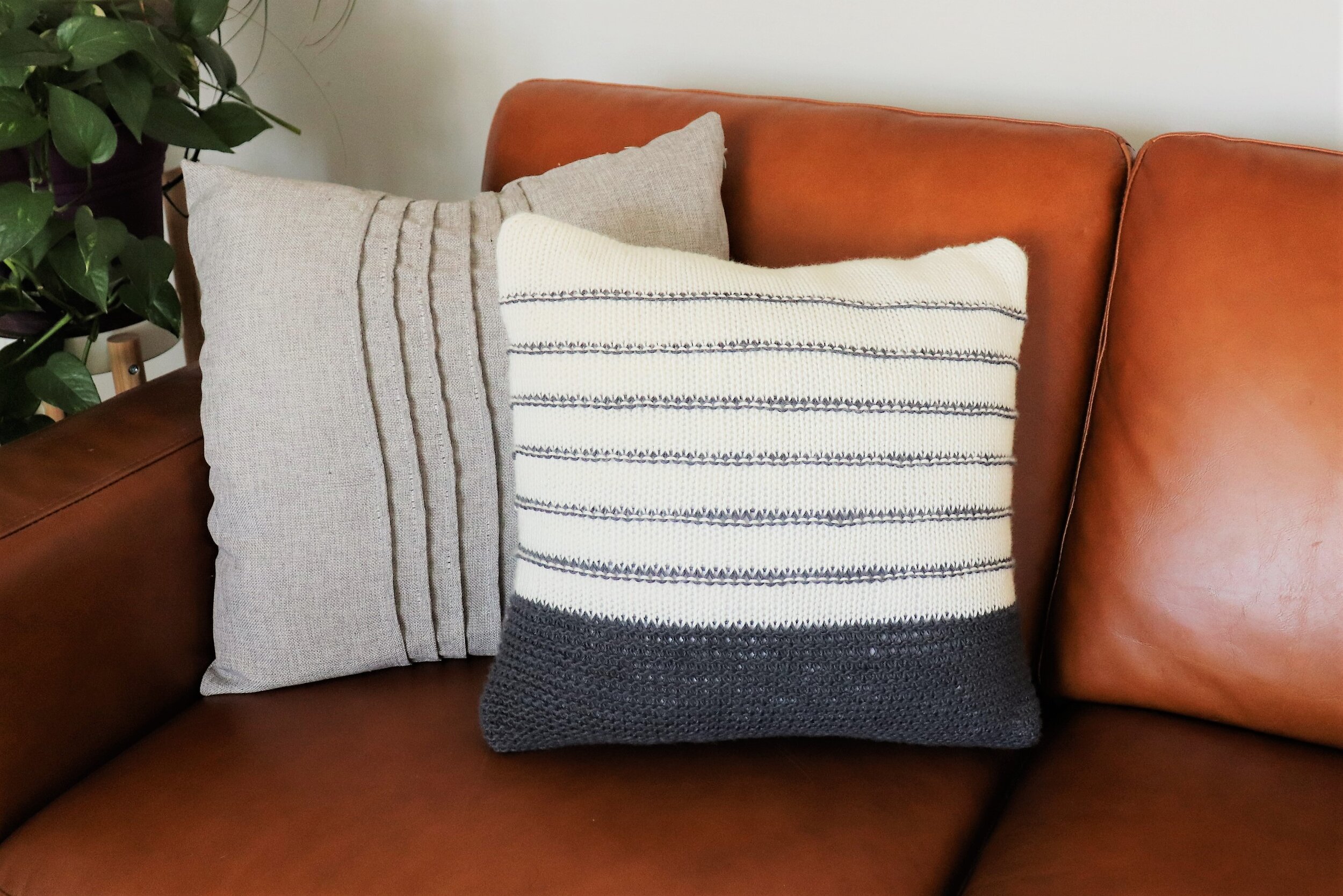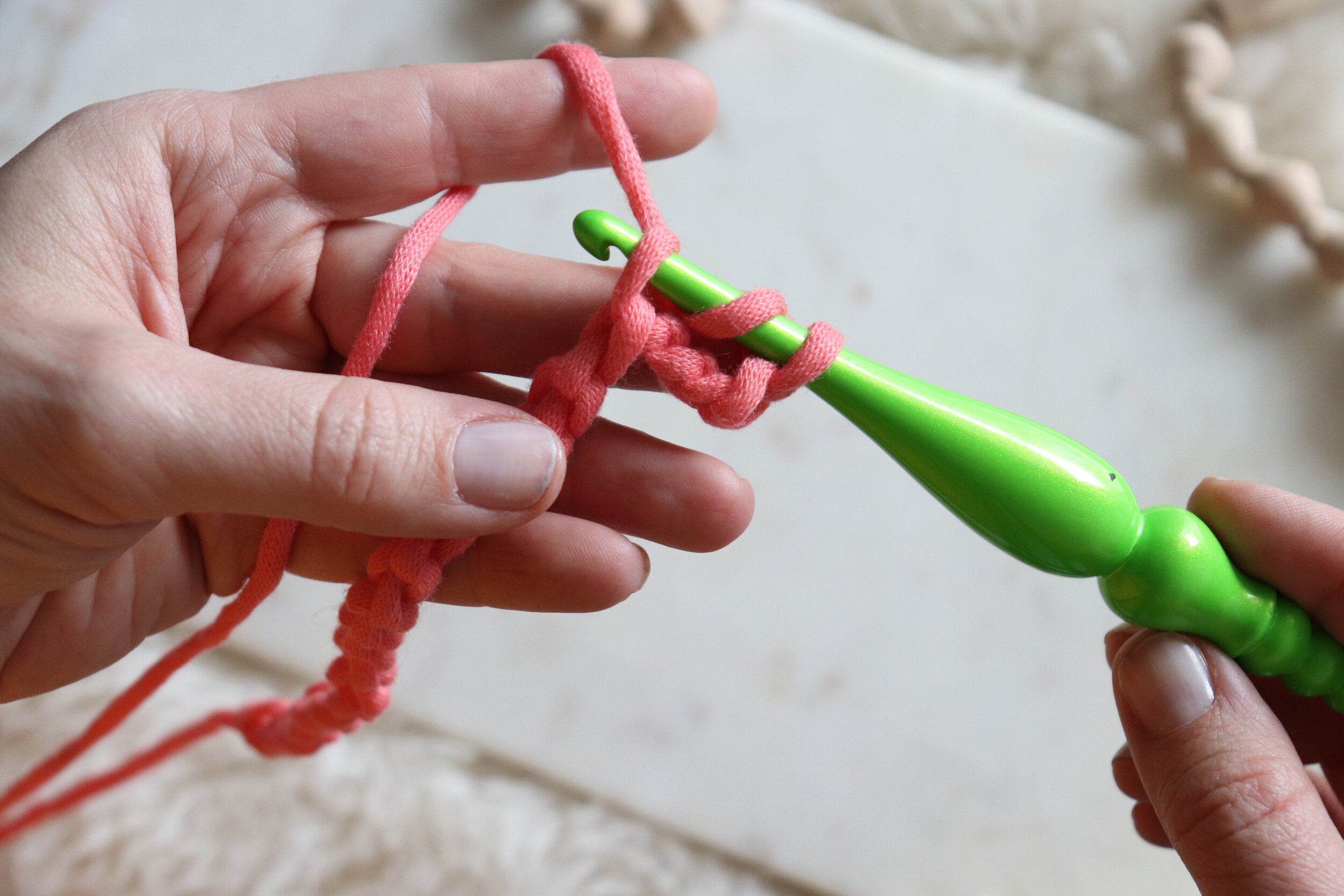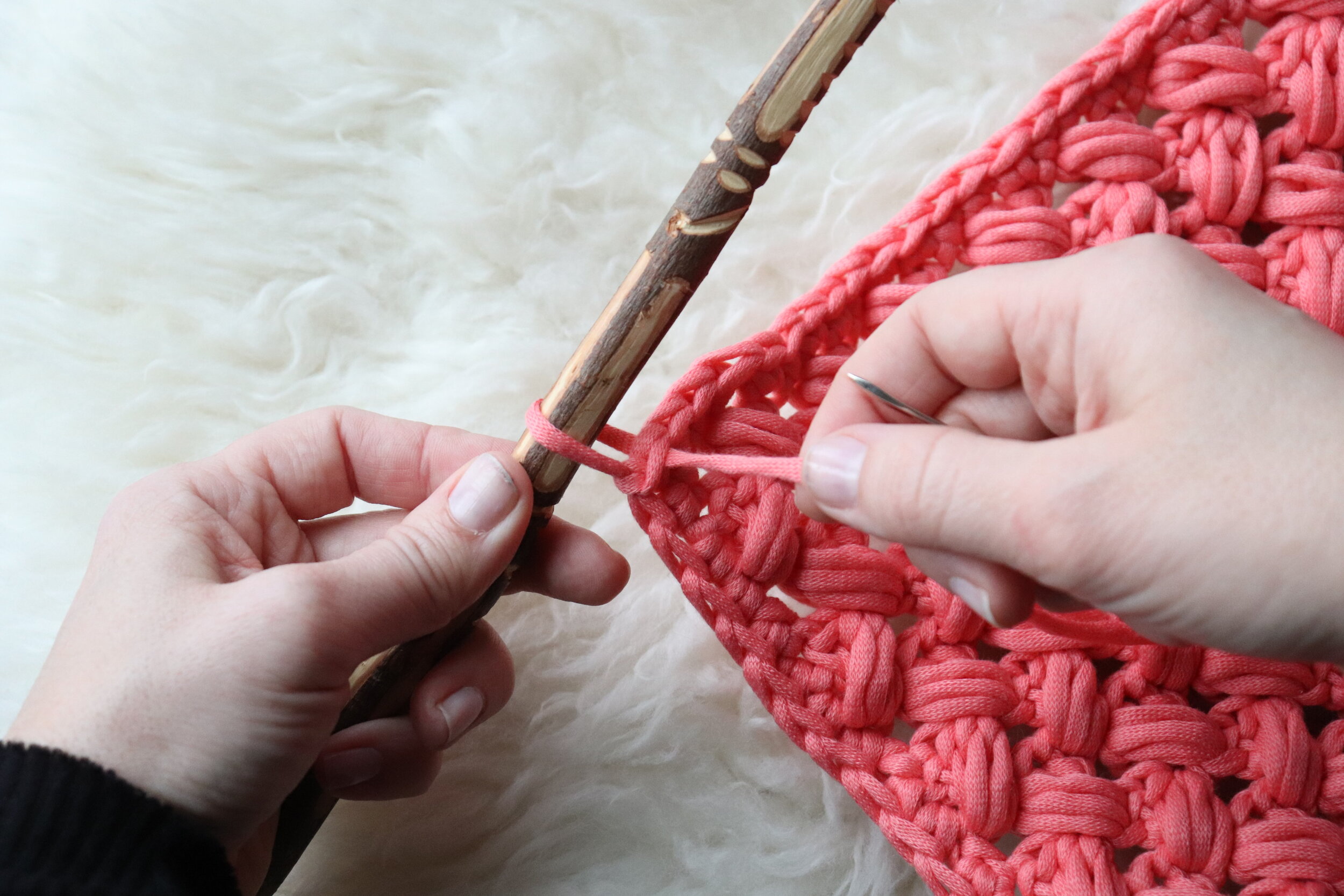Welcome, blog hop Furlers (and soon-to-be-Furlers)! I’m so excited to host Furls FiberArts’ March blog hop pattern!
Introducing the AJK Solitude Pillow! (I had an insta-friend ask me if I named the pillow before or after the “social distancing” of coronavirus 2020…it was before, I swear!)
I love decorating my 70-year-old midcentury home, especially with minimalist-inspired pieces that speak to the simple, cozy nest I’m always trying to create and maintain for my little family. Two dogs, two kids, a military husband, a couple of careers…life gets insane sometimes, and usually I joke that I’m just hanging on by my chipped-polished nails, but I’m honestly not joking most of the time.
A few years ago, when we lived in a 42-foot RV for over a year after moving to Maryland, we adopted an intentionally-minimal mindset. Well…let’s say minimal-ish. We really try to focus on collecting experiences- as a family and as individuals- instead of collecting things. Now…I love a good TJ Maxx trip. Like, LOVE, do you hear me?! Especially for home decor. But as I learned more about what living minimal-ish means to my family (sometimes in a not-so-pretty way), I began to find joy in creating pieces for my home that I absolutely adored; handmade pieces that communicated the simple, clean, fresh feeling I wanted for my home.
I promise you, my house doesn’t look as pretty as the pictures all the time. Not even some of the time! It’s more like there’s probably a room or two that looks somewhat put together at one time…anyone else? (Hello, giant GoldenDoodle puppy). Having these pieces in my home that bring me so much joy, and that means so much to me because I made them with my own hands helps to pull my little spaces together in a way that feels clean and cozy (even when it’s not quite there).
The AJK Solitude pillow is an easy level pattern, knit in the round on circular needles. The continuous construction of the body of the pillow creates the need for only two quick seams at the bottom and top of the piece! The pattern itself is straightforward and simple, and when knit up in the ultra-squishy and soft Furls Whims Merino yarn in worsted weight, it will fly off your needles faster than a season of Good Girls! (one of my knitflix faves!)
Let’s get started!
You’ll need:
Approximately 250 yards of Size 4 worsted yarn in two colors, preferably Furls FiberArts’ Whims Merino Worsted (103 yds/94 m per skein). I used approximately 120 yards of each color ( 2 skeins of each color, Charcoal and White—find them here !
There will be enough yarn left over to add tassels or fringe to customize your Solitude Pillow if you’d like!
Size 5.0 / circular knitting needles with your preference for cord length (at least 16”) . Furls will be debuting their gorgeous new line of circulars soon, so keep your eyes peeled here!
18” X 18” or 20” X 20” pillow form. I prefer to use down or down alternative forms for a little “heft” to my sofa pillows!
PRO TIP: You can also stuff your pillow with fiberfill stuffing! I recommend placing a clean pillowcase you no longer use inside the Solitude pillow once it’s knit up, like a liner, and then stuff your pillow with fiberfill! Simply flip down and tuck in the excess pillowcase once the Solitude pillow is full.
scissors and yarn/tapestry needle
stitch marker
A note before you begin:
The Solitude pillow is meant to be seamed on both the bottom and top of the pillow, so it will not be a removable cover for the pillow form. I actually just throw my handmade decorative pillows in the washing machine and dryer (with a wool dryer ball) and they have held up beautifully over the years, but if you would like to make your pillow removable from the form, you can attach buttons or even sew a zipper to the bound-off edge!
I highly recommend using the mattress stitch to seam the bottom and top of the pillow. It creates such a professional, polished look and is highly durable and helps the piece hold it’s shape. The mattress stitch can be used for both crochet and knitting, too! Even if you are a beginner knitter, there’s no reason why your beautiful hard work shouldn’t look as polished as possible! I’ve included a detailed video as well as a step-by-step picture tutorial—stitching together both garter stitch as well as knit stitch!— to assist you in learning this invaluable skill. Hopefully I’ve encouraged you to give it a try! Obviously, YOU are the boss of your own knitting, and you can use any seaming method you prefer in the pattern. ;)
Gauge: Obtaining gauge is not of dire importance when knitting a pillow, but it’s such an important part of a yarn crafter’s skills toolbox, and it would be so disappointing to spend so much time knitting a beautiful pillow only to discover it doesn’t fit your pillow form! Take the time to check your gauge.
Gauge for this pattern: 16 stitches across X 28 stitches tall (rows) in a 4” X 4 “ square.
Finished size laid flat before stuffing / inserting pillow form: 15” X 15'‘
Cast on 120 stitches using the long tail cast on method. Be sure to leave a decent amount of yarn length on the tail for easy seaming later on!
Join your stitches in the round and place your stitch marker.
For your first row, knit all stitches around (120 stitches) and slip your marker.
For row two, purl all stitches around (120 stitches). I know, I know it seems like a lot of purling! I use the continental method, and 1000% recommend learning to purl continental, but I know so many lovely knitters who enjoy purling english style, too! Because we are knitting in the round, which eliminates making a seam all the way up the side of our pillow, we create that crazy-good-squishy garter stitch texture by knitting one row, then purling the next. Knit a row, purl a row, for 32 rows total. It’ll go by in a flash, i promise, and you’ll feel so good about your amazing purling skillz once you’re finished. ;)
So knit row 1, purl row 2, and repeat this pattern for 32 rows total (you’ll end on a purl row). Take a second to measure your work—it should be measuring about 15” wide when laid flat (this will stretch to 18” or 20” once you insert your pillow/fiberfill stuffing!). It’s ok if it’s a smidge wider than 15”…it’s a pillow! Not the end of the world…or coronavirus, right?? ok, I’ll stop….
Hold up a second: YOU DID IT! YOU FINISHED THE GARTER STITCH PART! :::tiny party::
:Now we’re ready for our first color change, and entering the lovely land of those yummy stripes!
Row 33: Change to Color B (the creamy white color in my example), and knit all stitches around (120 stitches).
For rows 34-40, knit 7 more rows of Color B (so you should have eight rows total of Color B). Slip marker, and change to Color A (the charcoal color in my pic).
Row 41: Purl all stitches around, slip marker, and change back to Color B (whew, that wasn’t too bad, right?)
Just continue in this pattern of 8 rows of knitting in Color B and one row of purling in Color A for five more times. You’ll have six total sections of knit and purl stripes, or 54 rows of stripes. (86 rows total including your garter stitch section at the bottom). You should end on a purl row.
Row 87: Slip marker and change to Color B. Knit all stitches around (120 stitches).
Rows 88-106: continue knitting all stitches in the round (120 stitches per round).
Bind off all stitches. Yay! You’re almost there!
ALright, let’s stop really quick and take another measurement check. You should still be measuring about 15” across, and 15” tall. if it’s not exactly 15” it’s OK! You just want your pillow to be approximately the same length and width to create a square, and an inch or two smaller than your pillow form (if you’re stuffing your pillow, this isn’t a big deal, just make sure your pillow is square).
Let’s seam the bottom edge!
Again, I LOVE the mattress stitch. It creates the most professional, polished join between knit rows and I’m just kind of obsessed, ok? I know that the whip stitch method can seem really attrctive after all that knitting in the round, but just try it! You’ve put in so much work and used gorgeous Furls Merino yarn…your pillow deserves a beautiful finish!
I want you to try it SO MUCH that I created a little how-to video for seaming the garter stitched rows together:
Ta-Daaaa! You did it! Look at that beautiful seamed pillow booty. Spectacular!
Now it’s time to seam the top of the pillow…which means…STUFFING TIME!
Here’s where you can either insert a pillow form, or again, you can also stuff your pillow with fiberfill stuffing! I recommend placing a clean pillowcase you no longer use inside the Solitude pillow once it’s knit up, like a liner, and then stuff your pillow with fiberfill! Simply flip down and tuck in the excess pillowcase once the Solitude pillow is full.
To stitch up the knit stitched rows at the top of the pattern using the mattress stitch, you’ll use the same technique I demonstrated in the video above, but this time we won’t be looking for the “bands” under each set of v’s. I’ll show you:
Leave a long tail after binding off your stitches (Also: ignore my witch hands in the picture). Thread your tapestry needle with your long tail.
Find the first knit stitch right above your cast off edge. It’ll be a cute little “V” stitch—we will be using the two “legs” of the V to stitch up our top edge.
Insert your needle underneath the two legs of your first knit stitch beside the long yarn tail. Pull through, but not tight! Leave a little looseness in the seam—we will tighten that up in a bit.
Find the corresponding knit stitch on the opposite side of your cast off edge, and insert your needle under the two legs of that first knit stitch (see pic above). Pull yarn through, but again, not too tight.
Continue sewing the next knit stitch on each side of the pillow, back and forth, for a couple inches. I like to tighten as I go across my work to keep my stitches even. So here’s the magical part…Ready??
Hold your yarn tail with one hand, and the edge of the pillow with the other. Pull gently……..
…and Voila! Magic! Isn’t that the most satisfying experience?! I can’t even stand it sometimes. Continue the mattress stitch across the pillow, tightening the seam every few inches. Finish off.
Gah! The gorgeousness! I can’t! Can you tell I love order and symmetry? ;)
The next step is definitely not a requirement, but I hit my newly-stuffed pillow with a little steam on both sides. The stitches just lay so nicely against the pillow, and the seams soften up a bit. Again, totally not necessary…but so polished!
Congratulate yourself on making a beautiful, chic home decor piece that will hopefully bring joy and comfort to your little nest.
“One can be instructed in society, one is inspired in solitude.” - Gary Gilmore
“Then stirs the feeling infinite, so felt in solitude, where we are least alone.” - Lord Byron
Solitude is the great teacher, and to learn its lessons you must pay attention to it.” - Deepak Chopra
__________________________________________________________________________________________
Thank you for choosing to come on this home decor refresh with me! I hope you find solitude and joy as you stitch.
For those of you who like to read a traditional knitting pattern, I’ve included that below:
Definitions: K = knit, P = purl, SM = slip marker
Using the long tail cast on method, cast on 120 sts in Color A, join in the round. Place Marker. Leave a long enough length of yarn for a yarn tail to seam the bottom of the pillow
Row 1: K all sts, SM (120).
Row 2: P all sts, SM (120).
Row 3 - 32: Repeat rows 1 - 2, alternating K and P rows to create the garter stitch (120). SM. Change to Color B.
Row 33-40: K all sts, SM (120). Change to Color A.
Row 41: P all sts, SM (120). Change to Color B.
Rows 42 - 86: Repeat Rows 33-41 another 5 times, for a total of 6 repeats (54 rows total for this section) (120). SM. Change to Color B.
Row 87: K all sts, SM (120).
Row 88 - 104: repeat row 87 (120). Bind off, leaving a long tail for seaming.
Using the mattress stitch and the length of yarn of Color A from cast on, stitch bottom of the pillow. Finish off.
Insert 18” X 18” or 20” X 20” pillow form, or stuff your Solitude pillow with fiberfill polyester stuffing.
Using the mattress stitch and the remaining yarn from bind of in Color B, stitch top of pillow closed. Finish off.
And you’re done! Thank you for all the love you’ve shown the #AJKSolitudePillow on Instagram, and please tag me when you’ve finished your own wall hanging! I am @addisonjamesknits on Instagram.
You can also contact me at addisonjamesknits@gmail.com with any questions you might have; remember to check out the video tutorials as well!





















































